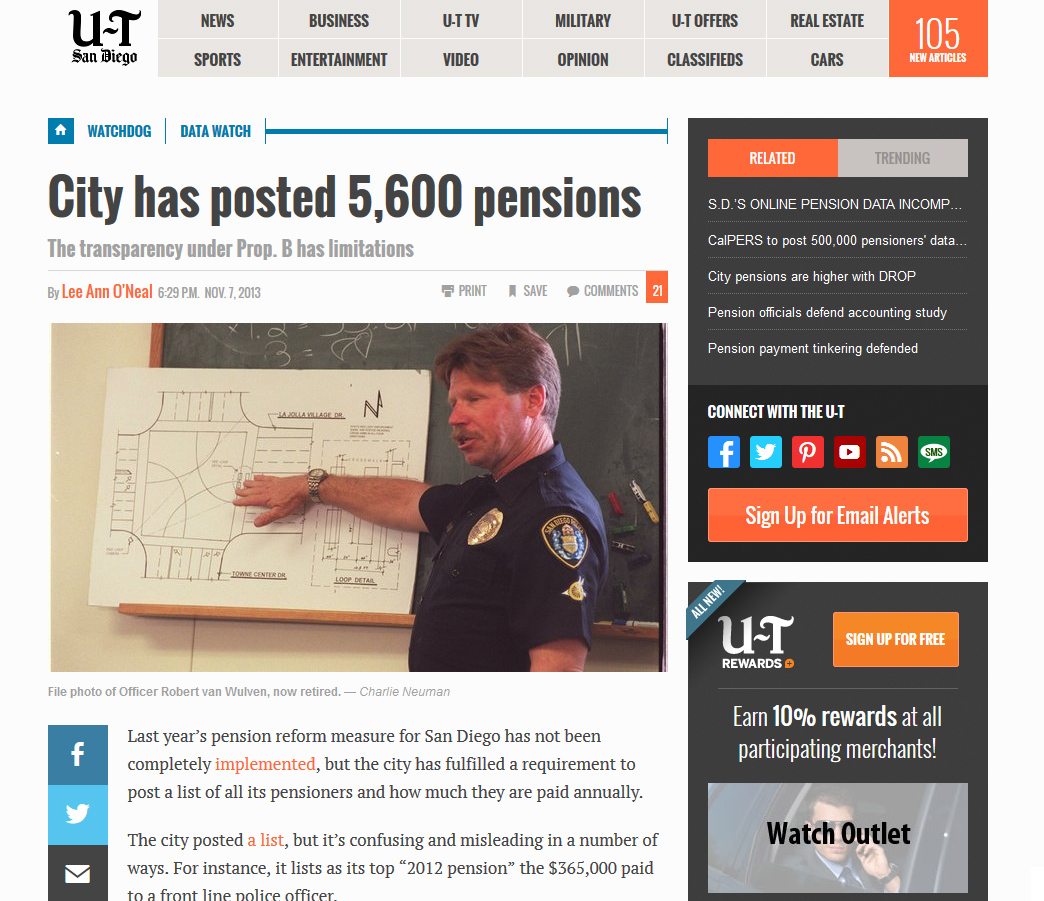Rae Ann McNeilly, Executive Director of Taxpayers United for America, provided commentary on San Diego pension policy for the U-T San Diego.
 Last year’s pension reform measure for San Diego has not been completely implemented, but the city has fulfilled a requirement to post a list of all its pensioners and how much they are paid annually.
Last year’s pension reform measure for San Diego has not been completely implemented, but the city has fulfilled a requirement to post a list of all its pensioners and how much they are paid annually.
The city posted a list, but it’s confusing and misleading in a number of ways. For instance, it lists as its top “2012 pension” the $365,000 paid to a front line police officer.
The listing provides no further information about the officer, not even a name, but U-T Watchdog followed up and found the pensioner in question is retired Officer Robert van Wulven, whose annual pension is about $73,000.
Van Wulven’s payment for 2012, as listed by the city, included a $291,738 lump-sum payout from a special retirement account into which he received retirement benefits while still working. That supplemental money is supposed to last van Wulven, 56, for the rest of his life.
The list posted by the city on its website contains these kinds of vagaries throughout, so getting a true picture of the annual benefits collected by retired employees without additional data and records requests is impossible.
[ Download spreadsheet created by U-T from city document ]
The list was posted as required by Proposition B, the pension overhaul passed with 66 percent of the vote in June 2012. The measure mandated 401(k)-style retirement plans, instead of guaranteed pensions, for most new city workers. Not all of its provisions have been put in place by the city, including a ban on pensions for city workers who commit felonies on duty.
The pension posting includes the final job title, years of service, and a total of payments made to that person from the pension system — including regular pensions and special account payouts all in one sum. For retirees who opted to roll their special funds into an individual retirement account, those funds are broken out separately.
The numbers shown appear simple but are not.
“It’s more of a keyhole than a window, but you do get a peek, and I applaud them for presenting it,” said Bill Holder, dean of accounting at the University of Southern California, who served for 10 years on the Governmental Accounting Standards Board. “The more sunlight that’s brought to bear on it, in my view, the better.”
Important information needed to measure adequacy or generosity of a pension benefit is not provided — salary information, hire date and age at retirement. Because there are no names attached, a multiple-year analysis is also not possible based solely on what’s on the city website.
It’s also difficult to discern whether the data released by the city shows a full year for each pensioner, because many have a partial year of payments when retiring and upon dying, which is not noted in the data.
The posting does mark progress in transparency when compared to the information made available by other governments.
Rae Ann McNeilly has obtained pension data from around the country for the Chicago-based Taxpayers United of America.
“Of the 19 states that I’ve analyzed pensions for, I’ve not yet seen the city or any level of government post pensions on a website, with or without a name,” McNeilly said. “There are 17 states that I’m aware of that don’t provide names and pension amounts.”
McNeilly said including names in the San Diego posting would be preferable, allowing people to “connect the dots on who the money is attached to.” She likened the current disclosure to a database of vendor payments with no company or contractor name attached.
“Those pensions are funded with tax dollars,” McNeilly said. “Any taxpayer-funded expenditure, the taxpayers have a right to review.”
The 2012 ballot measure explicitly said names would be omitted, “in a manner that protects the privacy rights of officers and employees.”
An unnamed fire captain took home the biggest total payment in 2012 of $694,315, including a $618,684 one-time rollover payment from the special account, the data shows.
The special accounts are part of the Deferred Retirement Option Plan, available to employees hired before 2005. They can begin collecting their retirement while still working, placing the funds in a special account for up to five years while still collecting a paycheck. They also cease accruing benefits when entering the program.
Among all retirees receiving pension payments in 2012, the median years of service was 25. The median payment listed under the city’s flawed “pension payment” column was $42,568.
Officer van Wulven said he doesn’t mind the pension transparency, even though he believes it will be used by people who wish to “mislead the public based on their particular agenda.”
He served more than three decades with the Police Department and said frustration directed at public-sector workers is better placed at the feet of officials who in past years failed to make full payments to the system.
“I’m not a millionaire by any means,” van Wulven said. “I worked for a long time and earned my pension, and I contributed to it, just like the city was supposed to.”




